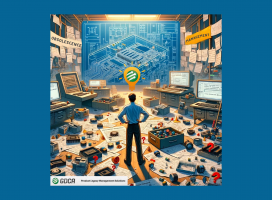Interview: Are Obsolescence Management Processes Crucial to Corporate Strategy?
In the following Q&A format, Holger Wussman, chief executive officer for Kontron Electronics, an electronic manufacturer service provider, gave his feedback to Tania Scroggie for the article “Why Obsolescence Management Processes Are Crucial to Support Corporate Strategy.” If you like the Q&A read the article, like and comment on our posts.
Tania:
It is a great pleasure to be in contact with you. As you have recently learned, I usually work with CEOs at embedded companies, advising them on strategies for successful, long-term sustainment of matured and discontinued products. They frequently share with me that their hunger for success and leadership can be challenged by issues involving the support of those products. These headaches have been acquired either through mergers and acquisitions or by extending products beyond their lifetime to keep key clients happy. I decided to contribute to the industry by writing a critical article about it. It will be an honor to receive your feedback.
Holger Wussman:
Your article is about a discontinuation policy, the potential plan to address it, and the forces inside a company who influence said plan. In order to talk about this, we must define key terms to ensure we are talking about the same things. It is my understanding we have two sides of obsolescence.
On the one hand, in the role of product owner, I must make decisions and define a policy on how to handle my product with regard to its age and lifespan. I have to define a schedule or rule as to when to announce the discontinuation of the product. There are many reasons to discontinue a product: parts may no longer be available, the product is no longer modern, or there may be better products on the market. These are valid for any industry and nearly any product; they are not specific to electronics.
On the other hand, I must decide how to protect my product from unavailability of required components. It is necessary to install an obsolescence management process. Normally this has three parts: reactive, proactive, and strategic O-management.
Two main influences contribute to discontinuing a product. First, I may want to force people to buy my new product, to stay modern (e.g., not selling winter clothing in the springtime), or another reason. Second, I might be forced to discontinue because of obsolete parts. O-management prevents this situation.
Tania:
Are the processes that you describe already documented processes at Kontron Electronics? What I heard is a beautiful vision of a CEO and the reasoning is right. The ideal traditional steps an embedded company should follow to discontinue products must be discussed early with all stakeholders, including clients. All issues should be assessed, especially upgradability, manufacturing feasibility, and increased cost of production.
The reason for my article, however, is that the vision of the CEO does not always become an internal process and hence not followed. Without a documented process to achieve that vision, each department would follow and execute their own version of their task. Sales would sell and manufacturing would produce. As an advisor to CEOs, I can’t emphasize enough the importance of translating visions into processes in order to achieve them.
Holger Wussman:
The art of good discontinuation policies is to find the right trade-off between the interests of all stakeholders. Normally for customers in the embedded field, long-term availability is important (e.g., return on investment [ROI] of high costs for certification); therefore, I need a good STRATEGIC O-management to select the right parts during development. At the same time, we have to try to avoid being unable to produce due to unavailable parts. That could be a big danger for the company and even greater for the customers. I must, therefore, be early enough with discontinuation before more and more parts become unavailable.
Tania:
Can you talk about the barriers that CEOs encounter when trying to put this vision into place and, perhaps, what they can do about them? You mentioned policies a few times in your response, which typically causes barriers in my experience. Are there others too? Are there any reasons and/or situations when you would not want to discontinue a product?
Holger Wussman:
From my point of view, we have a team play here, where all departments must supply their information about the used parts. Upper management together with product management and sales have to decide the right time for discontinuation.
It is my understanding that you must change the cause and effect. I need a united corporate strategy to be successful. The best continuation policies are key to this success; however, discontinuation policies or O-management are not the vehicles to attain a good company strategy. If I have a process where I have pre-calculated each order, and I have a rule that I do not produce anything with a margin below X, nothing dangerous can happen.
Stakeholders want to keep clients happy by supplying products beyond end-of-life. The client is a stakeholder, and clearly the most important one. The hunger for success and customer pressure lead to the difficult situation of getting all parts or earning enough money. In consequence, the customer struggles as well. In other words, both parties must have an interest in finding the right time for product discontinuation. The decision must be based on the best information resulting from an O-management divided three ways.
Nobody receives help if I cannot produce a product beyond a lifetime. Now, going back to your article, our discussion is a journey from two different starting positions and ending at a common destination. You started at your advisor position noticing that OEM CEOs’ visions are not rooted in reality. My starting point was the EMS/ODM CEO’s viewpoint.
The prototype of an ODM company, as I understood you, is a company like Kontron with their own products. The products are defined by themselves (product management), developed (R&D), industrialized (NPI) and produced (series). They have the decision-making authority about the timing of the announcement of their product’s discontinuation.
My decision about a discontinuation has a major impact on the life span of a customer’s product. I fully agree that several departments usually have various reasons to prolong the lifetime of my product. Discontinuation is not easy. Emotionally, it is my baby, and I have to let it go. Financially, there are no sales provisions anymore. Economically, there is no full amortization yet. From the customer’s side, there is pressure to not kill his product. There is no question that CEOs struggle with this task, especially when there is no preparation and no process.
The prototype of an EMS/ODM company is Kontron Electronics, our company. Our roots lie in the field of customer-specific products developed according to given requirements and specifications and the manufacturing service for products developed by third parties. We could be an outsourcing partner for legacy products, and sometimes we are. We therefore live with a different role model. We feel the duty to monitor the parts market and provide our customer, the ODM CEO, with the right information about discontinuation of parts, final buy dates, proposals for long-term stocking, and so on. That is the reason why, initially, I didn‘t see the conflict at a CEO’s level, because I don‘t have it as long as it is not our own product. (In the meantime, we have some products, none are discontinued.)
We can summarize that the biggest problem exists in a company where product management (i.e., a decision maker other than the CEO) has to decide about the discontinuation. That should be done on the OEM side, not the ODM or EMS side.
So how can we help the ODM CEO? I can only support your proposal to convert the CEO’s vision of an optimal discontinuation timing into a process and something like a criteria/KPI catalogue. Having a standard process helps to cope with the emotions. Everyone knows that the life of products end, and the process will kill my product; but we also know that there are more products to come. If everyone becomes accustomed to doing the same procedure every time, there would be no discussion about whether they should, but rather when and how.
The process should define a common criterion to help objectify the evaluation of the product’s strategic value. There should be limits for the percentage of the material costs versus the sales price; a minimum margin, which should increase with decreasing production lot sizes; a position in a ranking of the complete product portfolio of the company; and last but not least, the influence on the customer‘s product or company. You should also have a different policy of discontinuation if you are in the medical industry (e.g., compared to the gaming industry). That is the fundamental basis for being a valuable partner in the respective industry.
I end with the aspect of communication. If I keep my customer informed, everything is easier because he will not be surprised. The conflict between maintaining the old and developing the new has a kind of system immanence—there is no best solution for that. The right behavior depends on many factors.
In Germany, we have a saying: “If it were easy, anyone could do it.” To give advice here is not easy and not generally valid. There is another aspect we did not discuss—the contractual situation. Perhaps you have promised, as we often do, to deliver a product for a period of 15 years. With the first approach, you have no choice—you must deliver. The best you can do is monitor the parts market and identify the right time for a final redesign or for the discussion with your customer about the best step into the future.
Tania:
At GDCA, we are not an OEM, ODM, or CM. We deal exclusively with discontinued products.
Holger Wussman:
Yes! Understand, though, it is a different role and business model you follow. You focus on times beyond discontinuation. You are talking about life after death. We are down to earth. We focus on customers and their demands while the product is living!
Tania:
Yes, nicely said. Once the product crosses to the land of the dead, we offer customers the option of after-life product support or “electronic archeology,” as another CEO calls it. I have one last question to ask you about prioritizing the conversation with OEMs. Most OEMs, ODMs, and CMs have some type of obsolescence management strategy. Some are very sophisticated, and some barely react to obsolescence issues. Sometimes I just want to have a conversation about it. Many CEOs are interested in having the conversation but postpone it until they have more time. In the meantime, the issues of supporting zombie products continue. Do you have any advice as to how to generate urgency to discuss the subject?
Holger Wussman:
EBITDA [earnings before interest, taxes depreciation and amortization], create a sample calculation that shows how much money they are losing. That might help.
Tania:
Interesting! What else works with you?
Holger Wussman:
A cappuccino and strawberry cake.




